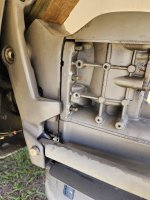Hello! Looking for some help. I own a 2008 Chaparral 224 SSX with a Volvo-Penta 5.0 Gx-J. Transom Assembly SX_Alt-32 and a DPS_A 1.95 Drive unit.
This boat has been pretty good to me. Have gave me more than a decade of fun and good behavior. Very little repairs needed if any. Just maintenance until now. Have to lift the engine, leak from the oil pan. The SELOC repair manual is telling me that although not necessary, but highly recommended to remove the Drive unit.
Here is the issue; I fallow all the steps indicated on the manual to remove the drive unit. Bolts, hydraulics cylinders, throttle cable etc. Read and fallow the instructions several times. But the unit does not want to come out. Used a technique from You tube, recommending to us the boat own hydraulic to push it out. Nope. I even use a small tractor to try to pull it (very carefully of course). Nothing. It pulls back by hand a bit under 1/2 inch. If I apply "extra" force about 1 and 1/4 inches.
A boat mechanic told me that, could be so much corrosion inside that is making it harder to pull it out.
I have attached some photos.
Any ideas??? Tips, recommendations, etc.
Thank You
R
This boat has been pretty good to me. Have gave me more than a decade of fun and good behavior. Very little repairs needed if any. Just maintenance until now. Have to lift the engine, leak from the oil pan. The SELOC repair manual is telling me that although not necessary, but highly recommended to remove the Drive unit.
Here is the issue; I fallow all the steps indicated on the manual to remove the drive unit. Bolts, hydraulics cylinders, throttle cable etc. Read and fallow the instructions several times. But the unit does not want to come out. Used a technique from You tube, recommending to us the boat own hydraulic to push it out. Nope. I even use a small tractor to try to pull it (very carefully of course). Nothing. It pulls back by hand a bit under 1/2 inch. If I apply "extra" force about 1 and 1/4 inches.
A boat mechanic told me that, could be so much corrosion inside that is making it harder to pull it out.
I have attached some photos.
Any ideas??? Tips, recommendations, etc.
Thank You
R















